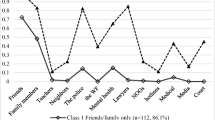Abstract
Socio-cultural and sociopolitical influences on women’s experiences of intimate partner violence (IPV) and their decision-making processes are not well-understood. This study characterizes help-seeking behaviors of Hispanic and non-Hispanic survivors using Liang et al.’s analytical framework and identifies differences in barriers to help-seeking between these cultural groups. Transcripts from two focus groups of non-Hispanic survivors and one focus group of Hispanic survivors were coded to identify similar and dissimilar factors impacting Liang et al.’s three stages of help-seeking. Though several barriers were common, Hispanic participants felt informal support systems were inaccessible and being involved in IPV was shaming. They preferred to not seek help but act to change their circumstances. Non-Hispanic participants described extensive experience with formal systems, but relied on strong self-advocacy skills for effectiveness. These findings highlight the importance of understanding the socio-cultural context in which decision-making processes occur in order to provide the best support to IPV survivors.


Similar content being viewed by others
References
Bauer, H. M., Rodriguez, M. A., Quiroga, S. S., & Flores-Ortiz, Y. G. (2000). Barriers to health care for abused latina and asian immigrant women. Journal for Health Care for the Poor and Underserved, 11(1), 33–44.
Bell, K. M., & Naugle, A. E. (2005). Understanding stay/leave decisions in violent relationships; a behavior analytic approach. Behaviors and Social Issues, 14, 21–45.
Black, M. C., Basile, K. C., Breiding, M. J., Smith, S. G., Walters, M. L., Merrick, M. T., Chen, J., & Stevens, M. R. (2011). The National Intimate Partner and Sexual Violence Survey (NISVS): 2010 summary report. Atlanta: National Center for Injury Prevention and Control, Centers for Disease Control and Prevention.
Centers for Disease Control and Prevention, (nd) Injury Prevention and Control: Violence Prevention: Intimate Partner Violence: Definition. Available at the CDC’s website at: http://www.cdc.gov/ViolencePrevention/intimatepartnerviolence/definitions.html.
Coker, A. L., Davis, K. E., Arias, I., Desai, S., Sanderson, M., Brandt, H. M., & Smith, P. H. (2002). Physical and mental health effects of intimate partner violence for men and women. American Journal of Preventive Medicine, 23, 260–268.
Denham, A. C., Frasier, P. Y., Hooten, E. G., Belton, L., Newton, W., Gonzalez, P., Begum, M., & Campbell, M. K. (2007). Intimate partner violence among Latinas in eastern North Carolina. Violence Against Women, 13(2), 123–40.
Flicker, S. M., Cerulli, C., Zhao, X., Tang, W., Watts, A., Xia, Y., & Talbot, N. L. (2011). Concomitant forms of abuse and help-seeking behavior among white, African American, and Latina women who experience intimate partner violence. Violence Against Women. 17(8), 1067–85.
Fugate, M., Landis, L., Riordan, K., Naureckas, S., & Engel, B. (2005). Barriers to domestic violence help seeking: implications for intervention. Violence Against Women, 11, 290–310.
Ingram, E. M. (2007). A comparison of help seeking between Latino and non-Latino victims of intimate partner violence. Violence Against Women, 13, 159–171.
Kantor, G. K., Jasinski, J. L., & Aldarondo, E. (1994). Sociocultural status and incidence of marital violence in hispanic families. Violence and Victims, 9(3), 207–22.
Kaukinen, C. (2004). The help-seeking strategies of female violent-crime victims: the direct and conditional effects of race and the victim offender relationship. Journal of Interpersonal Violence, 19, 967–990.
Klevens, J. (2007). An overview of intimate partner violence among latinos. Violence Against Women, 13, 111–122.
Klevens, J., Shelley, G., Clavel-Arcas, C., Barney, D., Tobar, C., Duran, E., Barajas-Mazaheri, R., & Esparza, J. (2007). Latinos’ perspectives and experiences with intimate partner violence. Violence Against Women, 13, 141–158.
Lewis, S. F., Resnick, H. S., Ruggiero, K. J., Smith, D. W., Kilpatrick, D. G., Best, C. L., & Saunders, B. E. (2005). Assault, psychiatric diagnoses, and sociodemographic variables in relation to help-seeking behavior in a national sample of women. Journal of Traumatic Stress, 18(2), 97–105.
Liang, B., Goodman, L., Tummala-Narra, P., & Weintraub, S. (2005). A theoretical framework for understanding help-seeking processes among survivors of intimate partner violence. American Journal of Community Psychology, 36, 71–84.
Patzel, B. (2001). Women’s use of resources in leaving abusive relationships: a naturalistic inquiry. Issues in Mental Health Nursing, 22, 729–747.
Sabina, C., Cuevas, C. A., & Schally, J. L. (2012). Help-seeking in a national sample of victimized Latino women: the influence of victimization types. Journal of Interpersonal Violence, 27(1), 40–61.
Strube, M. J. (1988). The decision to leave an abusive relationship: empirical evidence and theoretical issues. Psychological Bulletin, 104(2), 236–250.
Tjaden, P., & Thoennes, N. (2000). Full Report of the Prevalence, Incidence, and Consequences of Violence Against Women: Findings from the National Violence Against Women Survey. Washington, DC: National Institute of Justice and the Centers of Disease Control and Prevention. NCJ 183781.
U.S. Census Bureau (2006). Population Trends in the Hispanic Population: 2000 to 2006. Available at the U.S. Census Bureau website: http://www.census.gov/population/www/socdemo/hispanic/files/Internet_Hispanic_in_US_2006.pdf.
West, C. M., Kantor, G. K., & Jasinski, J. L. (1998). Sociodemographic predictors and cultural barriers to help-seeking behavior by latina and anglo american battered women. Violence and Victims, 13(4), 361–75.
Wolf, M. E., Ly, U., Hobart, M. A., & Kernic, M. A. (2003). Barriers to seeking police help for intimate partner violence. Journal of Family Violence, 18(2), 121–129.
Author information
Authors and Affiliations
Corresponding author
Rights and permissions
About this article
Cite this article
Mookerjee, S., Cerulli, C., Fernandez, I.D. et al. Do Hispanic and Non-Hispanic Women Survivors of Intimate Partner Violence Differ in Regards to Their Help-Seeking? A Qualitative Study. J Fam Viol 30, 839–851 (2015). https://doi.org/10.1007/s10896-015-9734-6
Published:
Issue Date:
DOI: https://doi.org/10.1007/s10896-015-9734-6




